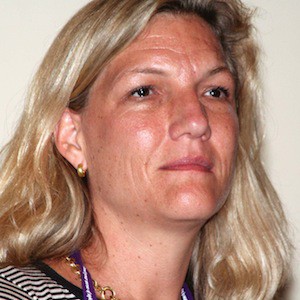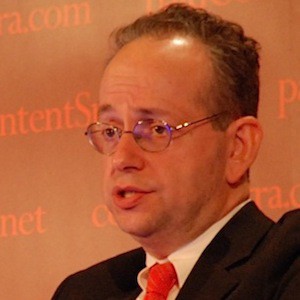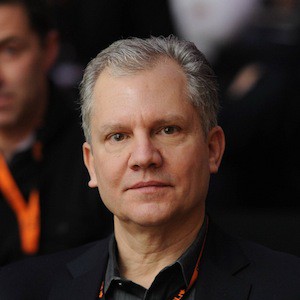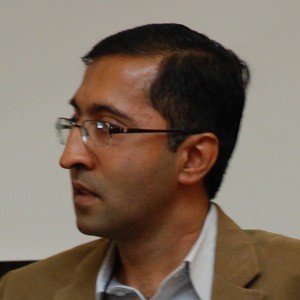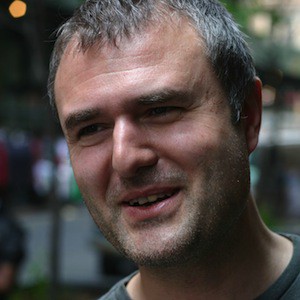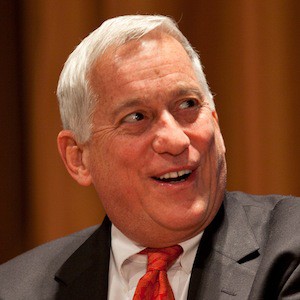Martin Nisenholtz: We are here with Marty Baron on April 4, 2013 at The Washington Post.
Paul: Paul Sagan and Martin Nisenholtz off camera. Thank you for a few minutes.
Marty: Sure.
Martin: We are doing this look at when journalism and news met technology. It isn’t just the period of the Web. It really does go back to video text, etc. You talked about, when we first walked in, covering some of those early systems. Maybe go back to those first experiences and what you covered and learned, and then fast forward through what the newsroom of today is going through.
Marty: Well, I was at The Miami Herald when Knight Ridder introduced ViewTron, and people saw that as something that would lead to a very different future for us. The company invested a tremendous amount of money in it. I was a business reporter there at the time, and so I was covering it. It was interesting, but they kept investing a lot of money and a lot of money, and then nothing came of it. It’s interesting, because we both saw the future and then I think people said, “Oh, well, maybe that’s not the future.” That was their reaction to it. It was interesting that years later, when I was at the L.A. Times and some of us were pressing some of our senior leadership to do more for the Internet, the managing editor at the time said, “Ah, yeah, Knight Ridder did that ViewTron thing. Nothing ever came of that.” Some of us said, “You know, the Internet’s very different than that.” This was at a very late stage. It was interesting to see that Knight Ridder was pressing on that.
Martin: That is interesting, because others have said that this video text experience essentially cooled the industry for a decade or more and caused the whole online services industry to evolve around the newspaper industry.
Marty: Yeah, I think that’s right. I’m not in a position to judge that. But having seen how people reacted to this huge investment that Knight Ridder in ViewTron video text and that it didn’t work out. They had no way of making any money off of it. If I recall correctly, they were actually giving people machines. No, they were having to pay for machines that cost a fair amount of money at the time. It was pretty limited, obviously. It was just basic text. It was not fast. There was nothing great about it. It was interesting, but it’s not as if the general population was eating it up, saying, “Oh, we’ve got to have this.” It’s some sort of replacement for their newspaper. They kept putting money into it. They kept not getting any money out of it.
Paul: Do you remember, just as a ballpark, what a lot of money was?
Marty: I’d have to go back and look at it. You’d have to ask Tony Ridder what he spent on it. I don’t know why the number’s sticking in my head, but I keep thinking $80 100 million. Somewhere around that.
Paul: One of the points that’s been made is… We’ve been playing with this metaphor of swimmers and the tide. The tide is so big it’s taken the swimmers, meaning the news companies, just out to sea with it. Which is, even if it was $80 or $100 million, that’s a lot to a company like that at the time. It’s not really to the tech companies that created some of the tide that’s just been too big to push back against. One of the other experiment they did was the tablet in the lab that they built, in Boulder, where the budget was only a million dollars a year. Which, when you try to think about, are you a tech company or aren’t you? It’s not table stakes in tech. You went through that and reported through that and then obviously rose up and became an editor of a number of big city papers and lived through the budget challenge.
But also the changing audience. So maybe talk about how the audience’s appreciation for news commodity versus brand and the value of the brand, the value of the package, has changed or not changed.
Marty: There’s so many trends that have affected us. My sense is that people are going to their passions. Their passions aren’t always based on geography. Newspapers have traditionally been based on geography. We have a community here. We have a community in Miami, a community in Boston, a community in Los Angeles. The assumption was that people were members of that community actually would want to have a product that covered the full range of things in that community. What I observed over time was that, in fact, the sense of community wasn’t nearly as strong as the other passions that people had. In fact, community wasn’t necessarily such a strong passion. It was much more important to them that they were an aficionado of a particular type of music, or that they were a member of a particular religious denomination or that they were obsessed with a particular sports team, than the fact that they lived in Los Angeles.
Or they lived in Boston or lived in Miami. That passion is really what drove their interests. There were all these sites that developed, that could appeal to them far more than a newspaper could. Because you could offer a site that offered every conceivable piece of information about your favorite pop musician, which no newspaper was going to offer.
People started gravitating to particular sites. It becomes an a la carte environment. If they wanted to read about the Red Sox, they could go to a particular site. If they were just obsessed by sports, they could go to ESPN.com. If they were interested in movies, they would be going to some of the entertainment sites that existed. If they were interested in politics, obviously there were things like Politico that grew up to appeal to them.
It was all eating at newspapers, at the edges, in terms of what readers’ habits were.
Paul: Let’s come back to politics in a minute. Because it is a big vertical in this market, in Washington. But hasn’t even the extension of what you’ve said been not even fragmentation by vertical, but almost by article. First search and then Twitter has turned it into, you’re not even going to a site. You’re going to a specific deep page or a story, which makes it even harder to figure out how to aggregate a business model.
Marty: Yeah, I think that’s true. Obviously, that’s true. I was just talking with someone, earlier this morning. We were talking about section fronts online. Probably not that important anymore. People are either going to the home page or they’re finding their way to the article. They’re finding their way to the article through search. They stumble upon it. They see it on Google News or on Yahoo. They see it somewhere else. They go to that story. It just happened to be the story that they found first. It’s not because they had any loyalty to our brand. It just happened to be the one that was most convenient. They may not even have noticed what site it was on.
Now we’re all struggling to keep them on the site once they’re there. We recognize that articles are the entry point for a lot of people, as opposed to the home page or something like that. It is a struggle, because people aren’t necessarily loyal to any particular brand.
The distinctions between one brand and the next may be important to us. We may think they exist. We firmly believe they exist. We have reasons for that belief. On the other hand, there are a lot of consumers who couldn’t care less.
Martin: We’re interviewing three different kinds of people, I would say: those who inhabit the traditional journalistic institutions; people on the opposite end of the spectrum, who have created some of these very large technology businesses like Twitter, Facebook and Google; so called new journalism folks, people who are inventing new models for journalism. Including local ones. The criticism that the tech and new journalism people bring is that the more traditional folks haven’t yet recognized how radically different the costs structures are. And while someone like you may think, “I’ve taken a huge amount of cost out of The Boston Globe newsroom,” from their context, it’s still 10 times too large.
Can you talk about the reality of that and what you think about that tension between, on the one hand, the entrepreneurs saying, “These people are still living fat and happy,” and your perspective on creating quality journalism?
Marty: Sure. I understand where they’re coming from. Of course, lot of their models are built on aggregation. They’re aggregating the work that we do. Of course they can maintain a lower cost structure. They’re not doing the original work. They don’t have to pay for it so they can keep their costs low. If we no longer existed, they wouldn’t have very much to aggregate. That’s one issue. I certainly believe that there’s huge value in quality, original journalism that’s done. It costs money for us to send people to Afghanistan to cover the war. It costs money for us to send people to Iraq to cover the war. It costs money for us to send people down the street to cover what’s happening there, to actually talk to witnesses and to put together a coherent story about what happened.
If we’re covering social issues in our community, it costs money to investigate those things. It costs money to do investigative work.
It doesn’t cost any money to take our story and link to it and say, “Look, we’ve built a business model by selling ads around that.” Of course they can have a much lower cost structure than we do. It doesn’t mean that we don’t recognize that they’re operating on much lower cost structures. I think we fully recognize that they’re operating on much lower cost structures.
But it’s kind of difficult for us to make that transition, to get to their point because if we cut our costs to their level, we won’t be doing any original journalism. We actually won’t.
Martin: They would argue that that thinking lacks a kind of recognition that there are all of these other contributors out there. Let’s talk more locally because Iraq and Afghanistan may be different examples, but they may not be. All of these folks are blogging and tweeting and creating whatever they’re creating from these places. We’re just awash in information. The new journalism is more about curation than it is about necessarily sending a reporter and then editing that reporter. Could you talk about that?
Marty: There may be instances where that works. Even if you have a train wreck, you’re going to get a lot of Tweets from people saying I was just on the train and it crashed. Who’s going to explain to you why it crashed? What were the circumstances? Nobody’s blogging on that. Nobody’s blogging on whether the person who was the conductor of the train was on drugs, or drunk, or fell asleep at the wheel, or anything like that.
They don’t know. They have no information about any of that. They have no information about whether the tracks were in proper condition. They have no information about whether the train was properly maintained.
They can’t Tweet about that. There’s nobody blogging about it. None of the engineers who worked for the Transportation Authority are blogging that “Hey, guess what? We haven’t been maintaining those tracks.”
The notion that all information is known, but it’s not necessarily available and it’s not put together in any coherent way for anybody to possibly understand. We just did a story here about the governor of Virginia who has a highly unusual relationship with a very unusual company that’s putting out a dietary supplement essentially.
It’s not clear that it has medical benefits, although some are being claimed. This company gave the governor, actually have paid for $15,000 of the wedding of his daughter. The governor’s daughter isn’t going to blog on that. The donor isn’t going to blog on that. The governor himself doesn’t plan to blog on that. The caterer didn’t blog on that. Nobody blogged on that.
Where did that information come from? Through the efforts of our own reporters. The Boston Globe just completed a series about the taxi business in Boston, and all the abuses that take place there, how the drivers are exploited essentially.
Taxi drivers can’t blog on that because they won’t get another gig. The owners aren’t going to blog on that because they won’t get another gig. Nobody’s sending out Tweets about any of that sort of stuff.
The only thing that gets sent out on Twitter about that is if somebody had a bad cab ride. There’s a limit to the kind of information that becomes available because of blogs and because of Tweets.
We have to be realistic about that.
Martin: Talk about that context of the priest scandal that you led at The Globe.
Marty: Shortly after I got there, we embarked on a series investigating the Catholic Church. The issue there was not just whether a priest had abused children, which there had been cases of that before, but whether there had been a pattern of abuse and that the church knew about that abuse and then reassigned priests to other parishes where they then abused again, and whether that pattern had taken place over a long period of time. In fact, it had in the case of dozens and dozens of priests over decades. Now, that was not something that anybody was going to tweet about. The priest abusers weren’t going to tweet about it. The victims weren’t tweeting about the abuse that had taken place. The church wasn’t tweeting about it. Nobody was tweeting about that. That kind of information would never have been known had it not been for The Boston Globe doing that expose.
Paul: One of the other themes that has come up is this concept of original sin, which is if the newspapers and the magazine companies, too, had just waited and not gone, “Everything is free,” and just said, “Our model is subscription. We just need to wait until that happens on the web,” the world would be a better place for all these companies today. That, obviously, flies in the face of the other thesis which is just the tide was too strong. You could not resist. If Reuters and Yahoo! Are going to set news and headlines free, you had to play in the free space.
Just wondering your thought about that as you went probably through those discussions in a bunch of newsrooms and today as paywalls have started to actually work. Have you thought about the decisions that were made then that maybe you were a part of, and would it have turned out differently if people had made different decisions, or has this just been the evolution, and we’ll do the best we can now?
Marty: I was never in a place where they actually considered charging from the beginning. I think everybody felt they needed to be in the game right away. Nobody knew exactly what the economic model would be. Initially, it was just we need to be there because everybody’s there, and it’s kind of this cool thing. Then people started to think about the economic model over time. I think once people started to think about the economic model, they were thinking much more in terms of share of market rather than total advertising or subscription models or how it would affect sales of the traditional print newspaper.
They needed to be the biggest game in town and they wanted to make sure that there was no other player there who was a bigger game online than they were. So, that became very important, and it has been important for some decades now where everybody felt they needed to be bigger.
We’re still in that game where everybody’s looking at each other’s comp score number. We’re looking at each others, in the extent they’re available, Omniture numbers and things of that sort. Rankings are very important.
I think people came to pay models very reluctantly and with some level of uncertainty because the economic model was based entirely on advertising revenue and in order to get more advertising revenue, you had to generate more page views.
Then they discovered that there were no riches at the end of that…
Martin: Because they put an infinite inventory…
Marty: That’s the problem. For those of us who have responsibility for generating those page views, you do feel like you’re on a treadmill. That you have to speed up and speed up and speed up, and you’re not actually making any real progress. You’re not moving anywhere. If you slow down at all, you’re just going to fall off. Yes, you’re creating more and more inventory. Everybody is trying to generate page views so there’s an unlimited amount of inventory. It’s basic economics that the value of the advertising is going to start to drop, the rates will drop. And sure enough, they have dropped. They may well continue to drop.
People are confronted with that and they say, “We’ve got to do something else, and by the way, look at the sales of our newspaper. They’re dropping off because we’re giving everything away for free.” So they’ve implemented these pay models.
A lot of people in newsrooms, journalists in particular, have said, “Oh, we should have charged all along.” But I don’t buy that. I don’t think we could have. I think, in fact, we would have ceded the territory to other people, and I think this has been part of the natural evolution of the web is that it’s just happened this way.
I think it was important that news organizations be out front, innovate. Seize market. Boston.com in Boston became a very big factor. Had they been charging all along, someone else would have been the biggest factor online. There’s just no question in my mind.
So now, they have to figure out how to make more money. The pay model is one way that they think they might be able to make more money. That too has yet to be fully tested, in my view.
It’s something we have to try. I think we have to try a lot of things. It’s one thing that people are trying. I don’t think it’s a panacea. It seems evident that it’s not the panacea.
Paul: What are some of the things that you think we need to try? Do you have thoughts about that, or is it just a general statement about innovation?
Marty: In a way, it’s a general statement about innovation. I don’t know exactly everything that we need to do because there are new things that people are trying. For example, here at the Post, we announced three months ago that we were launching a politics video channel. I think video on the web offers us the opportunity to be a disrupter rather than the disruptee.
I think the Post sees that opportunity. Politics is a sweet spot for the organization. We have an opportunity to do something interesting there. The advertising rates on video are much more attractive than they are particularly from ad networks that supply a lot of the advertising online.
Video is one area that I think we can do things. Another area is so called verticals of specializing in certain areas where you’re not trying to appeal to the mass audience, but you’re trying to appeal to the niche audience.
The advertisers who want to reach that niche are willing to pay a higher rate to reach them. For example, here at the Post, we have a lot of advertisers who are particularly interested in reaching people who have .gov and .mil addresses.
Rates tend to be higher for that. We try to do a lot of things that might appeal to that audience.





